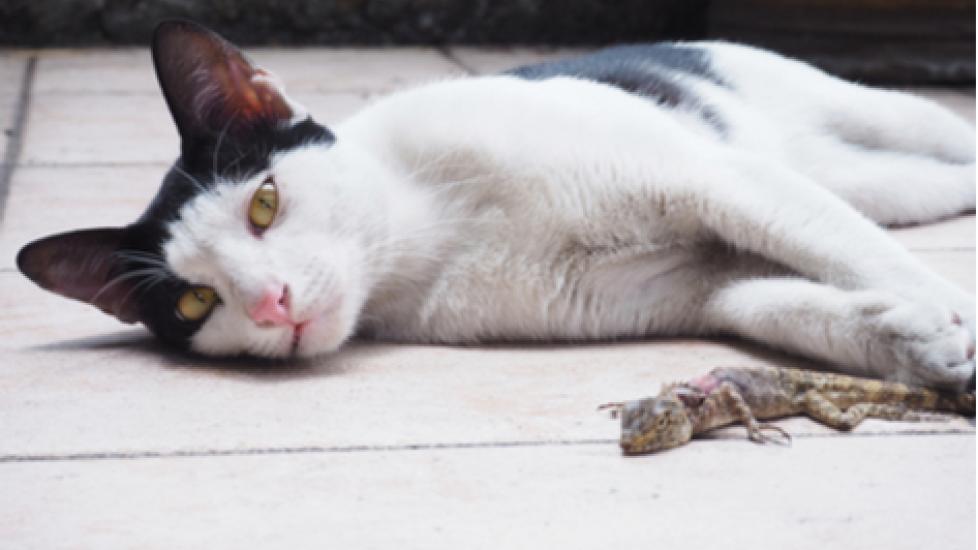What to Do If Your Cat Eats a Lizard or Frog
By John Gilpatrick
Cats, ever curious, will often stumble into trouble when allowed to explore outside. Trouble might take the form of a neighboring dog, a roaming racoon, or an infestation of fleas.
In some parts of the United States, “trouble” might also mean certain species of lizards, frogs, and other similar creatures.
Cats are natural predators, and many of these cold-blooded animals are easy prey—i.e., slow and small. But what will happen if your cat eats, either fully or partially, one of these critters? Should you worry?
Parasite Infections Related to Reptile Ingestion
One of the most concerning medical scenarios is the development of liver flukes, says Dr. Christine Rutter, a clinical assistant professor at the Texas A&M University Small Animal Veterinary Teaching Hospital. The parasite that causes this problem, Platynosomum fastosum, is generally found in the southern United States and Hawaii, she says, as well as other international tropical and sub-tropical regions (Central and South America, East Asia).
“This parasite infects the liver, gallbladder, and bile ducts of cats after ingestion of the parasite’s intermediate host, the anole lizard,” Rutter says. “The liver fluke matures over eight to 12 weeks, but cats may not become symptomatic for many months, if at all.”
Symptoms can include weight loss, abdominal distention, fever, lethargy, hiding, vomiting, diarrhea, and jaundice, Rutter says. If your cat starts showing these signs, you should seek medical attention for your cat right away.
That applies to any negative symptoms your cat is showing after eating a lizard or frog.
And because anoles and their accompanying liver flukes aren’t the only creatures owners need to be on the lookout for, it’s helpful if owners are able to take a photo or video of the reptile with their cellphone, Rutter says. “Veterinarians often know what toxic species are in the area, and pet owners are most helpful when they can image or identify pictures of the offending creature.”
Recommended Products
Reptiles with Toxic Skin
The cane toad is a native of the Gulf Coast, while the Colorado River toad is common in the southwestern United States. Rutter says the toxins these animals produce are potentially life-threatening within hours of exposure; dogs are also susceptible.
“Exposed animals typically have rapid-onset severe salivation, weakness, tremors, dilation of the eyes, seizures, or rapid heart rate,” Rutter says. “They should be rushed to a veterinarian’s office.”
Rutter adds that dogs or cats who are only drooling and not experiencing the other symptoms outlined above can have their mouths rinsed out with a slow-running hose to rid them of the toxins. However, if other symptoms appear, a trip to the emergency vet is in order as soon as possible.
Dan Keyler, a senior clinical toxicologist for the Pet Poison Helpline, shares his knowledge of some of the other toxic reptiles that commonly come into contact with pets.
Rough-skinned newts are salamander-like creatures native to northern California, Oregon, Washington, and southern Alaska, Keyler says. Newts produce a potent neurotoxin called tetrodotoxi in their skin gland secretions, the ingestion of which has the potential to cause cardiopulmonary arrest and death. Medical treatment should be sought immediately.
Pickerel frogs emit similarly life-threatening skin secretions, Keyler says. Their toxin is particularly irritating to pets’ eyes and mucous membranes, but ingestion can have severe consequences. Exposure is most common in northern and mid-eastern states.
For these toxins, Keyler says you can try washing your pet’s mouth out with water, though care should be taken not to allow the water to be swallowed. For redness of the eyes, you may also use saline or lukewarm water to irrigate the eyes and surrounding area to relieve irritation, Keyler says.
How to Protect Your Pet from Reptile Accidents
There are a number of steps owners can take to prevent exposure to these animals altogether.
The most obvious, of course, is to keep your cats indoors, Rutter says. “Indoor cats live significantly longer lives than outdoor cats due to their decreased risk of trauma, environmental hazards, and toxins,” she explains.
For a variety of reasons, however, this may be difficult. For those who allow their cats outdoor time, Keyler recommends always keeping an eye on your cat when he or she is roaming around outdoors.
“Be observant to any abnormal behavior or symptoms when bringing your pet in after being out in the yard, especially in the southeastern and southwestern U.S.,” he advises.
Even if your cat is only semi-outdoors, like on an enclosed patio—or “catio”—lizards and frogs are capable of getting indoors through small openings. If your cat spends time on a patio or other area near the outside, you may want to put up a protective mesh screen a foot high or more, Keyler says.
Finally, if you frequently find toads on your property, you may want to consider physically removing them, Rutter says. But, she cautions, if you choose to capture them by hand, use gloves and wash your hands thoroughly before touching your pet or any part of yourself.




